Henrico County Historical Society
PO Box 90775 Henrico, VA 23273 (804)501-5682 hchsinfo@yahoo.com
Open by appointment only






Henrico County Historical Society |
     
|
| Home | Henrico | Maps | Genealogy | Preservation | Membership&Contribution | Shopping | About HCHS |
|
2020 News
|
|
||||||||||||||
| Individual | $15.00 |
| Family (Husband, wife, children under age 18) | $20.00 |
| Student or child | $5.00 |
| Supporting | $25.00 |
| Corporate | $100.00 |
| Benefactor | $300.00 |
| Lifetime (One payment for individual or for husband & wife-exempt from further dues) | $500.00 |
Send payment to HCHS
P.O. Box 90775
Henrico, VA 23273-0775
or join at henricohistoricalsociety.org.
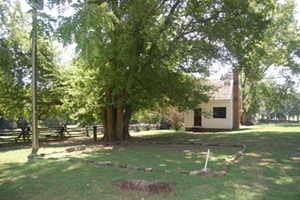
Henrico County has informed us that our project in cooperation with the Friends of Meadow Farm to create a 19th century interpretive kitchen building at the Museum will proceed this spring, subject to the approval of the Henrico County Board of Supervisors. This follows the Society's recent success in concluding a $300,000 fund raising campaign for the project. This goal was reached with substantial support from Marcus and Carol Weinstein (Weinstein Properties), Mr. Bobby Ukrop (The Honey Foundation), The Mary Morton Parsons Foundation, The Cabell Foundation, the Association for the Preservation of Henrico Antiquities, the County of Henrico, and others. We're grateful to all who've encouraged and supported the project to date and look forward to substantial progress in 2020.
It's underway. The image shows bricks outlining the potential footprint of the future kitchen building at Meadow Farm.
In the article in the last Henrico County Historical Society Newsletter ("The Chiswick School"), George G. Exall ran a boarding school in the 1850s and early 1860s at the house known today as Cheswick. However, aside from his educational endeavors, Exall was also a significant figure in the religious life of Henrico residents in the Ridge Road area, serving as the first to preach at Ridge Baptist Church. A 17 October 1853 letter from Silas Livermore to the Religious Herald tells of a meeting he had attended the previous day at the Ridge Meeting House, "a new edifice, about three miles and a half below Deep Run." The meeting was held there by Deep Run Church "one Sunday in the month" and that "Bro. G. G. Exall, the pastor, had a baptizing yesterday at Deep Run." So it seems that those whose primary place of worship was the Ridge Meeting House, they were baptized into the fellowship of Deep Run Baptist Church.
Original Ridge open-air structure. This drawing suggests the appearance of Ridge Baptist Church's first place of worship.
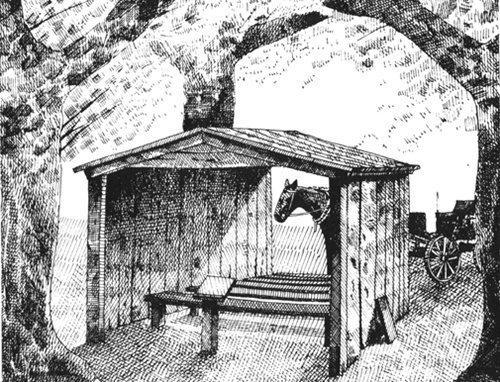
The following month on 22 November 1853, Rev. Exall wrote to the Herald from his home at Chiswick, and his letter provides interesting information about a very old church in Henrico's west end. He wrote: "About the time I moved to my present residence, some of the Deep Run brethren erected within half mile of my house, a slab shed with 2 sides coarsely boarded, and with seats to correspond. Here they meet on the Lord's Day afternoon to worship God. For some time but few attended except the giddy young persons, who found it a convenient rallying point, and while the brethren were engaged in acts of devotion and in earnest exhortation, exposing (as they said) their ignorance, many of their auditors were engaged in gossip and derision. But the day of small things was not despised. They held their way and grew stronger and stronger. Before long, however, horses and carts and other vehicles, were seen at the seats and the attendance was increased. But the booth did not afford shelter from the storms and cold of winter, and the brethren erected nearby at the intersection of the Ridge Road with Three Chopped Road, the Ridge Meeting House, a plain framed building 30 x 42 feet (this is however not yet paid for). Here a Sabbath School is conducted in summer and will be continued in winter when the house is plastered. I have preached at the Ridge for 2 years past on the first Lord's day in each month to people very much needing instruction and I am pleased to say I do not preach elsewhere to a more respected or prromising audience."
A letter of 12 October of the following year to the Religious Herald tells of a two-week revival that began on the third Sunday in September. In it Exall says, "The meetings at night were held at the Ridge M.H. (near my residnece). There I meet on each first Lord's Day a large and serious congregation."
We are most grateful to Ridge Baptist Church for providing this information through a loan of its "Centennial Historical Review, 1878-1978."
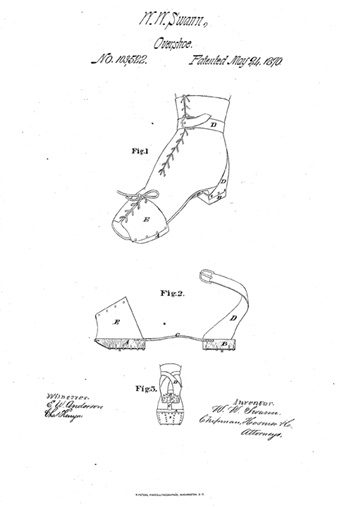
Nineteenth century gentlemen would probably not be found harvesting ice from a pond, but they would be walking on the pond with William W. Swann's spiked overshoes. Of course pond-walking wasn't his intended purpose for their use. They were meant to protect the wearer's shoes in "muddy and unpleasant weather" and facilitate walkng on icy sidewalks. As the illustration shows, they consisted of a toe that laced up attached to a sole and heel that were held in place by an ankle strap. Not only did they protect the shoe, but Swann also claimed an additional benefit for them because "the atmostphere has free access to the shoe and foot, they are beneficial to the health of the wearer." However, given the spikes on the soles, it seems as if the bad weather walker would need to don the shoes outside the house, and he might fear for his health if he wore the spiked overshoes into the house on hardwood floors.
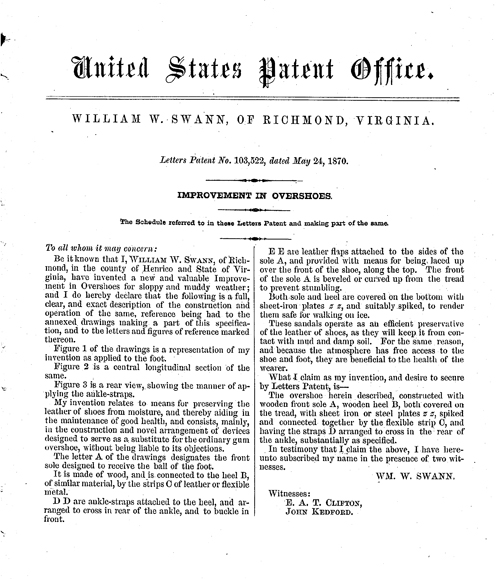
As time passes and as this remarkably mild winter wears on, I feel increasingly distanced from my days as a "free-range" child. In the 1960s, my friends and I roamed far and wide from our Forest Avenue neighborhood-springs spent exploring what we called Timber Lake off Quioccasin Road, summers hiking along Riverside Drive and around the Westham river gauge, and fishing in Westhampton Lake on the University of Richmond campus.
It was a frigid winter trek to that lake that seems to distant and different now. Carrying my father's hand-me-down hockey skates and several pairs of socks to make them fit, I was going skating on the frozen lake. And I wasn't alone. The lake was crowded with single skaters, hockey players and lines of people playing crack the whip; and was it ever frozen. As the ice expanded, it would issue a thunder-like boom and cracks would appear. The fractures, as I recall, seemed to indicate an ice sheet of at least 12 inches. Of course, time might be making me aggrandize my pat, but I can say for sure that the ie was really thick.
To me it was a wonderful playground; but a century earlier, it would have been a veritable windfall for anyone willing to harvest the ice. In the days before refrigeration, ice was a necessity, and that necessity often had to be imported from colder climes. A brief article in the 3 July 1854 Daily Dispatch headlined "Fired in the County" indicates its value. It reads, "About half past 10 o'clock on Friday night last the ice house of Mrs. Mildred Hutcheson, in Henrico county, was set on fire and destroyed. Mrs. H's loss by the conflagration will not fall short of $500, as she has lost a large quantity of ice, besides the house." That translates to roughly $15,000 today.
Perhaps the 7 January 1860 Daily Dispatch illustrates the importance of ice to the populace since its front page actually carries two accounts of the ice produced by what one article calls "this severe spell." One article notes that "Ice in abundance will be gathered in this locality and throughout Virginia."
Since ice is an article of very considerable commercial importance, and having a supply of domestic manufacture will enable us to keep in our own pockets a large amount of money that has been for some years paid to the North." Under the heading "Getting Ice," the other article also touches on the regional pride associated with local ice "Ice dealers in Henrico are busily filling their ice-houses with beautiful ice, from six to ten inches thick, and as clear and bright as any to be had at the North." It also notes that "ice venders in Henrico county think they will be able to supply all the wants of the city, next summer with home productions," thereby freeing up funds to be invested in "home manufacture." of course, there were hazards, and a brief ice-related third piece just below the previously cited article noted under the heading "Cold Dips" that two men "engaged in cutting ice in the basin yesterday, fell into the water and were decently ducked."
1875 apparently marked another profitable cold snap, or what the 23 January Daily Dispatch terms the "polar wave" which "furnished a home supply of this indispensible article." The newspaper reported that "A block of ice five and a half inches in thickness was left at our office door yesterday by Colonel John B. Young of Henrico. It was cut from 'Young's Pond,' a few miles north of the city." It was reportedly part of 100,000 bushels of ice gathered from his pond and was characterized as "the best ice that has been taken there for many years."
And three years later, the James River Steam Brewery at Rocketts took advantage of the 10 degree weather to harvest ice from neighboring ponds. The 9 January Daily Dispatch reported that the river was frozen from shore to shore and that "As far as the eye could reach long trains of wagons were seen moving up and down from the James River Brewery" causing a blockade of many carts filled with Virginia ice.
While the brewery stored its ice in its vaults, individual farms required ice houses; and as Mrs. Hutcheson's earlier mentioned loss illustrated, those structures were valuable, often highlighted in ads for real estate sales. For example, a 10 November 1862 ad for the sale of a property in Henrico near the Deep-Run Turnpike touted it's "three superior Ice Houses, all in excellent order, with the privilege to the purchaser of cutting ice from the adjoining pond." And like the ice houses, ice ponds were valued as well. The 20 March 1855 Daily Dispatch points out that a "small FARM on the south-west side of the Deep Run Turnpike about 6 miles from the city" featured "an excellent meadow, which would mke a fine ice pond."

When Henrico's Sheppard family occupied Meadow Farm on Mountain Road, there was, of course, an ice house as well as an ice pond. While the pond remains, the ice hosue is long gone; but a 1978 archaeological report by William T. Buchanan, Jr. dealt with what he felt was its likely site. For the study, exploratory trenches were dug, and they revealted the structure's dimensions and character. That work indicated a rough date of 1830-1860 for the six-by-twelve foot structure's construction. Buchanan also refers to an 1843 entry in an account book that indicates that a man named Jepe Shepperson was paid to dig the ice house and to other Sheppard papers that record the hanging of an ice house door in 1854. Buchanan hypothesizes that a row of bricks laid end to end on each end of the structure's site supported the ice house's superstructure. He believed the house featured a roof probably covered with clay for insulation and having a trapdoor centered in it. The image shows the depression in the ground, which is the likely location of the former ice house at Meadow Farm; it is up the hill behind the Visitor's Center and a bit beyond the ice pond.
Unfortunately, the Meadow Farm ice house is only a memory, like the Westhampton Lake ice and my old skates. But like the ice harvested by enterprising individuals in nineteenth century Henrico, they are all valuable and pleasant to recall.
Joey Boehling
Competing Sources: The ads at the right from the 8 May 188 Daily Dispatch feature a "country ice" ad sandwiched between two ads for "Northern ice".
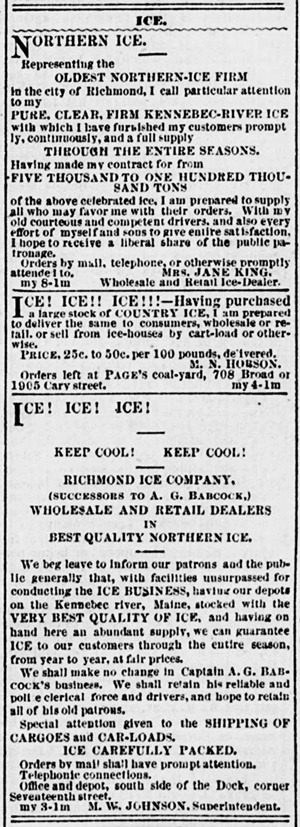
Aerial view. The photograph below of Meadow Farm shows the locations of the ice pond and ice house.

The source. If ice didn't need to be purchased for Meadow Farm, it was harvested from this ice pond.
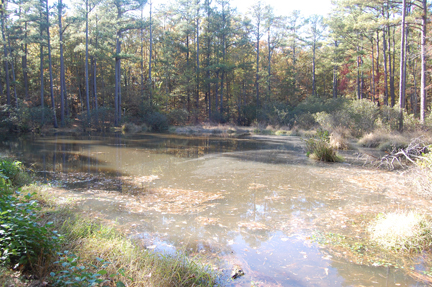
Schematic. The 1978 archaeological study of Meadow Farm offers this proposed diagram of the ice house.
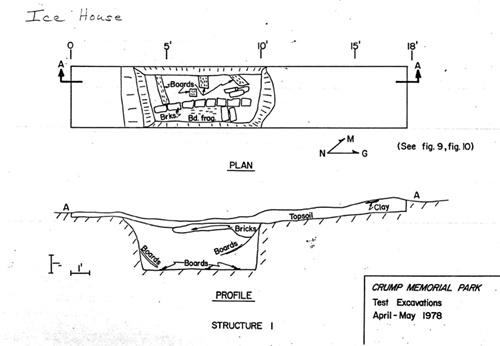
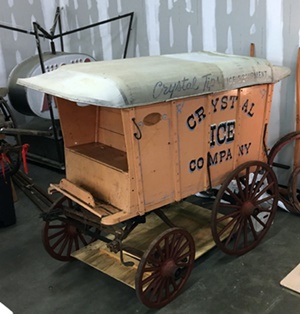
Among the myriad of significant historical artifacts owned and cared for by Henrico County is a late nineteenth century horse drawn, canvas topped ice wagon - a vivid reminder of how ubiquitious items in our daily lives can so easily disappear. (Can you say, "Phone booth"?).
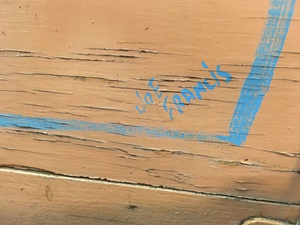
Crystal Ice Company had started in 1971 in Laurel and purchased the wagon in the early 70s. However, the company used it as an advertising tool rather than for delivery until donating it to Henrico County in 1985. Restored for the county by Carol Givens and Tom Snyder, the wagon also bears the signature of Joe Francis, the painter of the vehicle.
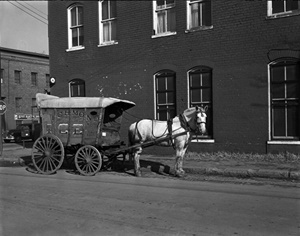
Left is a picture taken in Jackson Ward of Richmond Ice Company's wagon pulled by Nellie and driven by deliveryman George Seay. It appears to be identical to the Crystal Ice Company wagon, suggesting the original source of the latter.
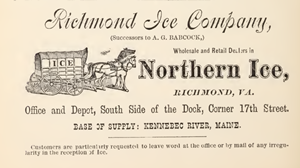
The card from the Richmond Ice Company boasts of the company's access to "Northern Ice," the traditional and largest supplier of ice. However, mid-nineteenth century newspapers regularly pointed to the desireability of harvesting local, or "country" ice to avoid sending money north.
Keeping windows open can be a Weighty Matter.
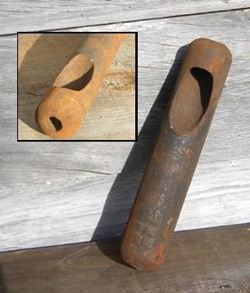

Congratulations to Haywood and Mary Jo Wigglesworth and to Causey Davis, who correctly identified the "What do you know?" items from the last newletter as sash weights. Causey noted that he recognized them from firsthand experience with the windows in his 100-year-old house.
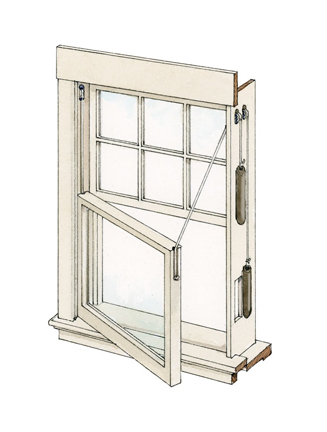
In fact, those pictured above are eighteenth and nineteenth century weights, while most people are more familiar with the more commonly seen weights with loops at the tops.
As the illustration shows, rope (sash cord) connected to a recess in the side of the sash and ran up the window frame to a pulley. The cord then ran through the hole in the top of the weight. It was tied in a knot, and the knot was pushed back into the opening. The weight would be concealed by the window jamb and would move up and down as the window was opened and closed, counterbalancing the sash in order to keep it at the desired height. Of course, the length of the cord was critical - too long and the window would not stay fully opened, too short and the window would not fully close.
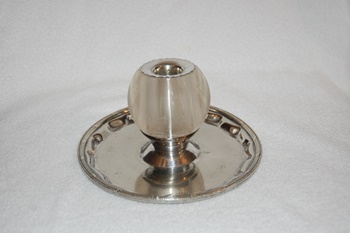
The glass and silver plate object at the right is 3 inches tall and 6 1/2 inches wide. The surface of the glass piece is ribbed with fine horizontal ridges from top to bottom.
Do you know what it is?
Email your answers to
jboehling@verizon.net
News 2020: First Quarter
Second Quarter | Third Quarter | Fourth Quarter
Home | Henrico | Maps | Genealogy | Preservation | Membership | Shopping | HCHS